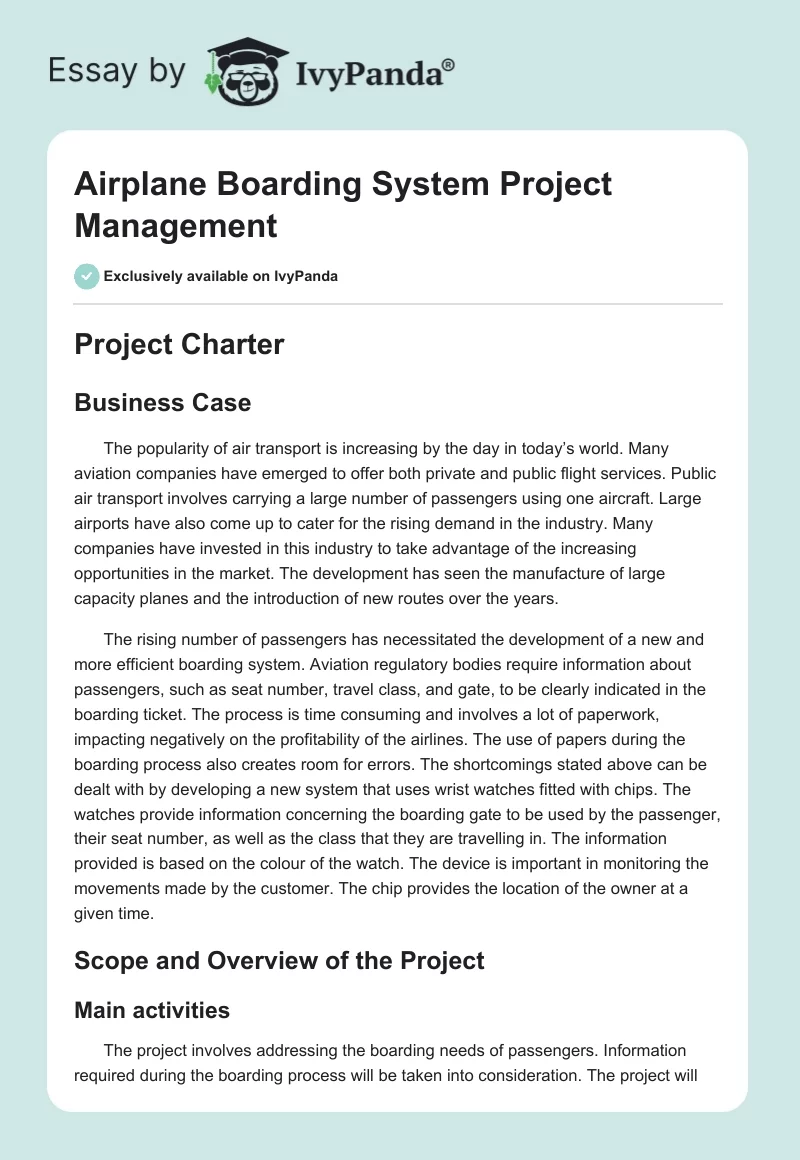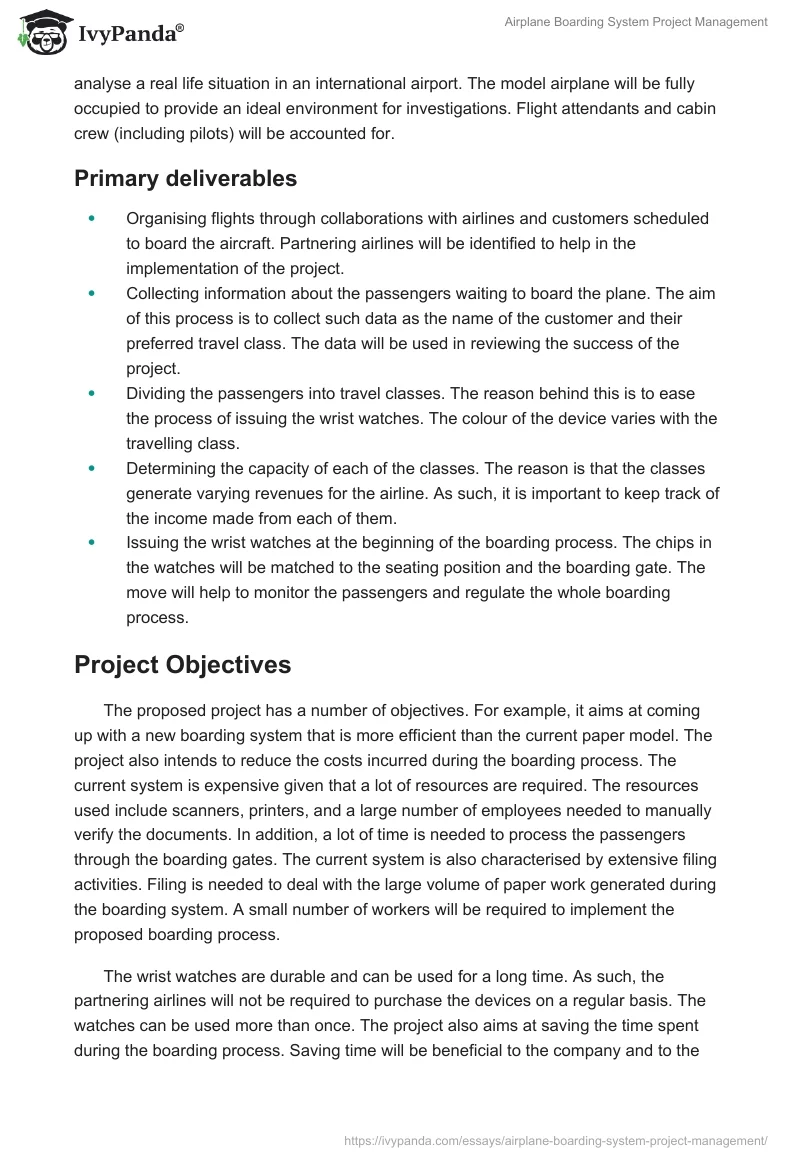Project Charter
Business Case
The popularity of air transport is increasing by the day in today’s world. Many aviation companies have emerged to offer both private and public flight services. Public air transport involves carrying a large number of passengers using one aircraft. Large airports have also come up to cater for the rising demand in the industry. Many companies have invested in this industry to take advantage of the increasing opportunities in the market. The development has seen the manufacture of large capacity planes and the introduction of new routes over the years.
The rising number of passengers has necessitated the development of a new and more efficient boarding system. Aviation regulatory bodies require information about passengers, such as seat number, travel class, and gate, to be clearly indicated in the boarding ticket. The process is time consuming and involves a lot of paperwork, impacting negatively on the profitability of the airlines. The use of papers during the boarding process also creates room for errors. The shortcomings stated above can be dealt with by developing a new system that uses wrist watches fitted with chips. The watches provide information concerning the boarding gate to be used by the passenger, their seat number, as well as the class that they are travelling in. The information provided is based on the colour of the watch. The device is important in monitoring the movements made by the customer. The chip provides the location of the owner at a given time.
Scope and Overview of the Project
Main activities
The project involves addressing the boarding needs of passengers. Information required during the boarding process will be taken into consideration. The project will analyse a real life situation in an international airport. The model airplane will be fully occupied to provide an ideal environment for investigations. Flight attendants and cabin crew (including pilots) will be accounted for.
Primary deliverables
- Organising flights through collaborations with airlines and customers scheduled to board the aircraft. Partnering airlines will be identified to help in the implementation of the project.
- Collecting information about the passengers waiting to board the plane. The aim of this process is to collect such data as the name of the customer and their preferred travel class. The data will be used in reviewing the success of the project.
- Dividing the passengers into travel classes. The reason behind this is to ease the process of issuing the wrist watches. The colour of the device varies with the travelling class.
- Determining the capacity of each of the classes. The reason is that the classes generate varying revenues for the airline. As such, it is important to keep track of the income made from each of them.
- Issuing the wrist watches at the beginning of the boarding process. The chips in the watches will be matched to the seating position and the boarding gate. The move will help to monitor the passengers and regulate the whole boarding process.
Project Objectives
The proposed project has a number of objectives. For example, it aims at coming up with a new boarding system that is more efficient than the current paper model. The project also intends to reduce the costs incurred during the boarding process. The current system is expensive given that a lot of resources are required. The resources used include scanners, printers, and a large number of employees needed to manually verify the documents. In addition, a lot of time is needed to process the passengers through the boarding gates. The current system is also characterised by extensive filing activities. Filing is needed to deal with the large volume of paper work generated during the boarding system. A small number of workers will be required to implement the proposed boarding process.
The wrist watches are durable and can be used for a long time. As such, the partnering airlines will not be required to purchase the devices on a regular basis. The watches can be used more than once. The project also aims at saving the time spent during the boarding process. Saving time will be beneficial to the company and to the customer. For example, the airlines will be able to handle more clients, while the travellers will reduce the amount of time spent in airports.
Project Exclusions
The project is limited to air transport. Other forms of transport, such as rail and sea, will not be part of this undertaking. In addition, only the wrist watches fitted with chips will be used for boarding purposes. The passengers are not required to produce any form of documentation to transit through the airport. The watch will provide all the information needed by the airlines to keep track of the passengers. For example, the device will indicate the seat number, the gate to be used during boarding, and the class boarded. However, it is important to note that the device does not entitle the customer to any special treatment during the flight. What this means is that all passengers will be treated the same way they would have been handled in the absence of the new system. The measure is very important in reviewing the success of the project.
To this end, the positive attributes noted during the monitoring and review process will be solely associated with the project and not with other changes made by the airline. It is also important to note at this juncture that the use of the wrist watch is limited. For example, the device will not be used for other proposes apart from boarding. As such, the passengers are required to return the watches to the airline after the flight. The device is also to be used for a single trip. What this means is that passengers who need to connect flights will use a different watch to board the new plane. It should be worn on the wrist during the flight. Customers will be discouraged from putting it in their luggage or in other locations where the flight attendants may not see it. All passengers must be wearing the device for easy identification and monitoring throughout the journey.
Milestone Schedule and Acceptance Criteria
Acceptance Criteria
- The project will attract enough customers. It is noted that the test flights should be at least 75 percent full.
- The cost of the new boarding system will be lower than that of the current arrangement. If the expenses incurred in the new system are the same as those associated with the current model, then the significance of the project will be watered down. The same applies when the costs are higher than the prevailing ones.
- The watches will be ready prior to the flight.
Milestone Schedules
- Preparation of the watches and fitting them with chips.
- Training staff on how to match the devices to seat number, gate used, and travel class. The crew and flight attendants are crucial to the success of this program.
- Booking of the aircraft to capacity. As already indicated, a capacity of 75 percent is needed. If this is not achieved, it will be hard to determine the viability of the project.
- Scheduling the flight.
- Issuing the watches to the passengers at the start of the flight. In addition, the devices should be retrieved from the customers at the end of the journey.
Due Dates
- Watches should be ready at least a month before they can be used in commercial flights.
- Staff training should take place at least two weeks prior to the launch of the project.
- The aircraft should be fully booked a day before the flight.
- The flight should be scheduled as soon as the aircraft is booked to capacity.
- The watches should be issued to the passengers only at the beginning of the boarding process.
Risks
The project is likely to encounter the following risks:
- Technological problems, especially when fitting the watches with the chips. The risk will be managed by contracting the services of reputable firms that have previously dealt with similar technology.
- Insufficient number of passengers to meet the required threshold. The problem may lead to the cancellation of the flight. The profitability of the airline will also be reduced. The risk will be managed by ensuring that sufficient time is provided for booking.
- Last minute cancellations by passengers. The risk would impact heavily on the airline’s profit margins. The risk will be dealt with by requesting down payments upon booking the flight.
- Damage to the watches and the chips. As a result, the cost of implementing the project will rise. The risk can be handled by purchasing durable devices and installing protective casings, such as rubber and plastic.
- Technological failure in the chip monitoring system. The usefulness of the chip in showing the location of the holder will be compromised. The chips can also get lost easily. The risk can be addressed by ensuring that the network used is secure and inaccessible to unauthorised parties.
Stakeholders
List of Stakeholders
- Project sponsor
- Project manager
- Project team
- Passengers
- Airline
- Competitors (other airlines in the aviation industry)
Stakeholders’ Concerns
- The sponsor is mainly concerned with the success of the project in easing the boarding process and cutting on operational costs.
- The managers are concerned with the time schedules, planning and coordination, guiding the team, and budgeting for the available resources to enhance accountability.
- The project team is interested with achieving the project objectives and offering assistance to the manager.
- The passengers are concerned with the safety of the wrist watches, the impacts of the new boarding system on flight costs, and the efficiency of the project.
- The airline is concerned with the efficiency of the new system and the implementation costs.
- The main concern of the other airlines is the competitive edge provided by the new boarding system and the quality of services offered.
Team Operating Principles
Clear Statements of Operation
- Activities must be concluded in a timely manner for the project to succeed.
- Work should be shared out among all members of the team. There will be no room for laxity.
- The activities of the team must be in line with the set objectives.
- Mistakes should be reported and collected as soon as they occur.
Communication and Meeting Statements
- A meeting should be convened as soon as one of the milestones is achieved. The next activity will be planned for during these conventions.
- Communication is vital to the success of the team. Team members should maintain close relations to promote communication.
Requirements Documentation
Business Need
The popularity of air transport is attributed to the fact that businesses are globalising their operations. Employees are expected to make frequent flights to branches located across the globe. The tourism sector has also greatly impacted on the popularity of this mode of transport. Every year, millions of tourists travel to various destinations across the globe. A rise in the number of passengers has prompted airlines to expand their operations. As a result, fierce competition is experienced between different airlines as they seek to cash in on the growing market. Many of the companies have opted to offer incentives to customers with the aim of attracting more clients. Such incentives include lowering the price of air tickets. As a result, airlines can compete favourably with investors in other means of transport, such as electric trains and cruise ships.
Today, many people prefer air transport over other means of transit as a result of efficiency and affordable prices. However, airlines need to improve their operations to remain profitable. Boarding is one of the areas that can be improved on. With the introduction of the watches, airlines can ease the boarding process. Time will be saved since less paper work is required. As a result, passengers will not have to wait for long before their flight is processed.
The new system is expected to attract more customers. Airlines will cut on operational costs, a process that translates to more profits. The wrist watches can also be reused, eliminating the cost of purchasing new ones. The expensive chips are tiny, which means that they can get lost easily. Inserting them in wrist watches reduces this risk. Since the holder is required to wear the watch throughout the flight, it cannot get lost easily.
The project will address the need for faster boarding services as less time will be required to process flight information. In addition, the wrist watch has some ornamental value. As such, the clients will feel appreciated by the airline, adding value to the flight experience.
Requirements
Functional Requirements
- To establish a new boarding system for air travel by using wrist watches fitted with chips.
- To create a comprehensive and automated paperless boarding system.
- To allow passengers to board within a short duration of time in order to provide competitive services in the aviation industry.
- To briefly demonstrate to the passengers how the new system works prior to the flight.
- To control traffic and reduce congestion in airports by speeding up the boarding process.
- To ease the work of the cabin crew in commercial aircrafts by ensuring that passengers can guide themselves during the boarding process.
- To lower the costs associated with boarding aircrafts, generating more income for the airlines in the process.
- To trace the location of the passenger to prevent the loss of the device and to account for all persons on board.
- To assemble a team to oversee the implementation of the new system. The team will be composed of engineers, technicians, cabin crew, and flight attendants.
- Acquire funding to tender for the chips and wrist watches, monitoring devices, and the software needed to ease the boarding process.
- To order the required equipment from reputable firms. The watches and the chips will be combined in the desired manner to ease the boarding procedure.
- To integrate the new system with the appropriate support technology to enhance its functionality.
- To test the new system before implementation in order to identify and plan for possible shortcomings.
- To note the problems associated with the new system and make the necessary changes to improve on its functionality.
- To train cabin crew and flight attendants on how the new system works to make them efficient facilitators.
- To reduce the possibility of mistakes during the boarding process.
- To cut on operational costs by reducing the number of workers, eliminating the current paper system, and reusing the watches.
Non-functional requirements
- Ensure smooth boarding across the globe.
- To guarantee the passengers of a fast boarding process that will save on time otherwise spent in the airport preparing the necessary papers.
- To ensure that customers experience high quality services in an attempt to retain them in the future.
- To improve the welfare and security of the passengers since their location can be traced when the need arises.
- To reduce on waste generated in airports in terms of boarding papers.
- To ease record keeping among airlines. Filing will no longer be needed and information can be retained in computerised servers.
- To reduce the time required to retrieve boarding information for past flights.
- To ease the work of the cabin crew since the passengers will get more involved in the boarding process.
- To easily allocate the available space in aircrafts without any confusion in seating positions since the wrist watch corresponds to a particular seat number.
- The total revenue generated by each flight will be acknowledged since the airlines will have information on the number of watches issued to passengers in all travelling classes.
- Training the cabin crew will help airlines to improve the quality of services offered.
Stakeholders’ requirements
The requirements of the stakeholders involved in the project are listed in order of priority.
Project sponsor
- The major requirement of the sponsor involves the success of the project. They will require the manager and the team working under them to come up with a suitable and feasible business plan. The sponsor will also expect the team to carry out a review of literature on similar projects for them to get information on the tasks they are to carry out.
- The sponsor also needs to be assured that the revenue generated with the help of the new boarding system exceeds the costs incurred during its implementation. The business should break even as soon as possible to start earning profits.
- The stakeholder will need assurance that the team charged with the responsibility of implementing the changes is qualified and has the necessary skills. Their commitment to the project will also be of great importance to the sponsor.
Project manager
- The manager will require the sponsor to fully fund the project. Prompt funding is needed to make the necessary purchases and to pay the team involved in the implementation process.
- The manager will also expect the sponsor to avail funds in a timely manner for the project milestones to be achieved within the timelines stipulated in the work plan. People working on the project need to be paid on time for them to remain motivated.
- The manager needs to be assured by the project team and the sponsor that they will offer support throughout the implementation process. They should also show commitment to the project and be ready to sacrifice their resources to see to it that the implementation succeeds.
Project team
- Team members will require the sponsor and the manager to ensure that funds are available to keep the project going. The business plan should be approved on time to ensure that the funds are released.
- They will also need assurance from the sponsor, the manager, and fellow team members that they will be committed to the success of the project
- Clear guidelines from the project manager on what is expected of them are needed. They also require clearly defined tasks and guidance on how to effectively accomplish them.
- The team will need their views to be taken into consideration. Since they are professionals in their fields, their opinions should be respected.
Passengers
- A flawless system that does not lead to confusion during the boarding process is required. The new model should ensure that less time is spent in boarding aircrafts.
- The cost of flights will not be hiked following the implementation of the new system. The system should enhance the efficiency of the services offered at no extra cost.
- The technology used in the proposed boarding system should be easy to comprehend and use.
- Enough watches will be availed to avoid last minute cancellation of flights. The devices should also be functioning properly.
- The wrist watches should be presentable. There should be uniformity, meaning that the devices should be identical.
Airlines (Client)
- A flawless boarding system that will guarantee the comfort of the passengers, attracting more customers in the process.
- Technology that they can afford to implement on a large scale once the success is guaranteed.
- A system that is easy to manage and which is not labour intensive. The new technology should increase profits by reducing operational costs.
- The airline also needs assurance that once the project is tested and proven, technical assistance will be provided to manage it. Routine maintenance will also be carried out by the team members.
- Information concerning the new system, including its advantages and limitations, is disclosed to help the airlines tackle any problems that may arise.
Competitors (other airlines)
- Competitors need assurance that the new system will not interfere with their operations in the airport.
- That the airport authorities will ensure that the airline using the new system does not receive any preferential treatment in terms of resource allocation.
- Policy makers in the aviation industry do not show any form of bias when dealing with airlines. All players should be allowed to freely carry out their activities as long as they adhere to the rules and regulations set out.
Project’s Scope Statement
Justification
The wrist watches will be issued prior to boarding and will be collected at the end of the flight. Care will be taken to ensure that the chip fitted in the watch reflects the gate used and the seat number. The colour will also be taken into consideration to ensure that it reflects the class boarded. The traceability of the chips will help to monitor the location of the holder. The new boarding system will then be compared to the currently used paper model. Airlines will improve service delivery with the new system, increasing their profits in the long run.
Scope Description
- Implementing the new system will help save the time spent by passengers in boarding airplanes prior to commercial flights by over 30 percent.
- The project will encourage more people to travel by air by making it the most efficient means of transport in terms of boarding. The number of people using this mode of transport is likely to increase by over 35 percent within a span of one year.
- The project will help airlines increase their revenue by about 25 percent. The cost of operations will reduce approximately 30 percent. A small number of employees will be needed and the cost of purchasing and printing boarding papers will be eliminated.
Product Acceptance Criteria
- The project will succeed if at least three quarters of the aircraft’s capacity is booked.
- The airline adopting the project will retain or improve its customer base following the introduction of the new system.
- The revenue collected by the airline after the project is implemented exceeds the costs incurred.
- The new system is profitable to the airline compared to the current one.
Project Deliverables
- Advertising the new boarding system through media to create awareness in the market. Marketing is expected to increase the enthusiasm with which the project is adopted by the stakeholders.
- Getting a reputable airline to partner with in testing the project. It will be very expensive and uneconomical to purchase planes to test the system.
- Training the cabin crew on how the new boarding system works. The employees will then be expected to brief the passengers on the requirements of the new system prior to the flight.
- Scheduling the flight on which the new system will be used.
- Availing the devices prior to the flight.
- Making arrangements for passengers to book flights to test the efficiency of the new system.
Project Exclusions
- No other means of transport will be used apart from air.
- The introduction of the system will not result in an increase in charges. Subsequently, the airline is not expected to adjust other services apart from those involving boarding.
- No boarding papers will be provided to the passengers. Instead, they will be issued with the wrist watches.
- No passenger will be issued with the boarding wrist watch before clearing the flight charges and going through all the protocols involved in boarding commercial aircrafts.
- No refunds will be made to passengers who cancel their flight without a three day notice.
- No policy changes concerning the operations of the airline will be made. As a result, both the passengers and the airline will be comfortable in trying out the new system.
Project Constraints
- Difficulties in convincing airlines to adopt the new system. Some stakeholders may be opposed to the move.
- Confusion among the passengers during the boarding process given that they are not used to the new system. When customers are not sensitised beforehand, they are likely to make mistakes and develop negative attitudes towards the system.
- Last minute cancellations by passengers will result in losses, which may create a negative impression on other airlines.
- Technological failures, making it hard to implement the new system. The model can only work when the chips fitted in the watches are functioning properly. The chips require constant monitoring using computer systems.
Project Assumptions
- Both the airlines and the passengers will embrace the system.
- Revenues generated by the new system will be higher than the costs incurred during implementation.
- There will be enough wrist watches for all the passengers. The devices will be available within the stipulated deadline.
- The budget for the project will not exceed what is indicated in the business plan. There will be no shortage of funds.
- The project will succeed, leading to large scale adoption by airlines.
- Prices will not be hiked.
Work Breakdown Structure
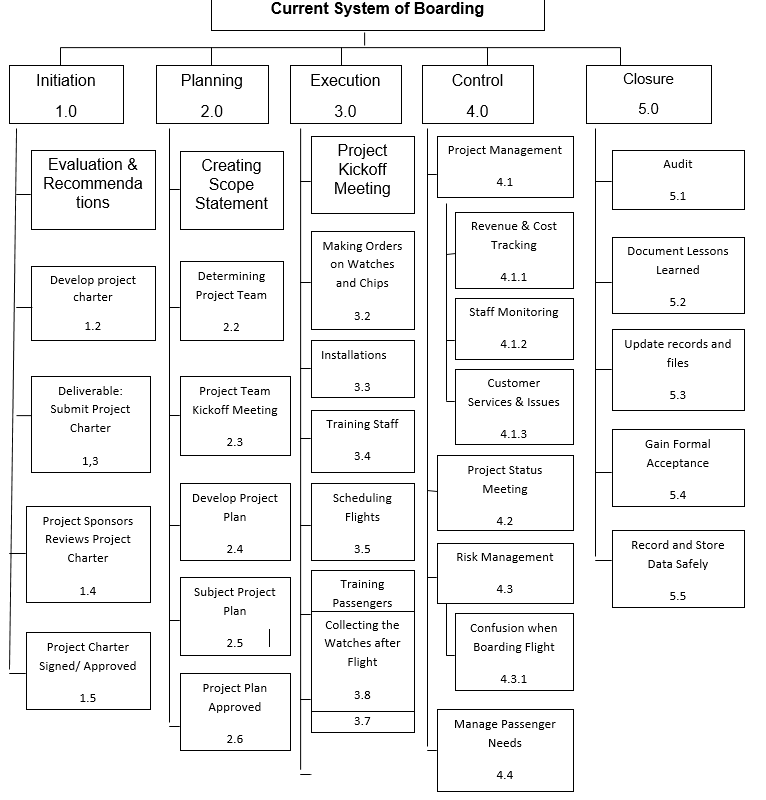
Project Schedule
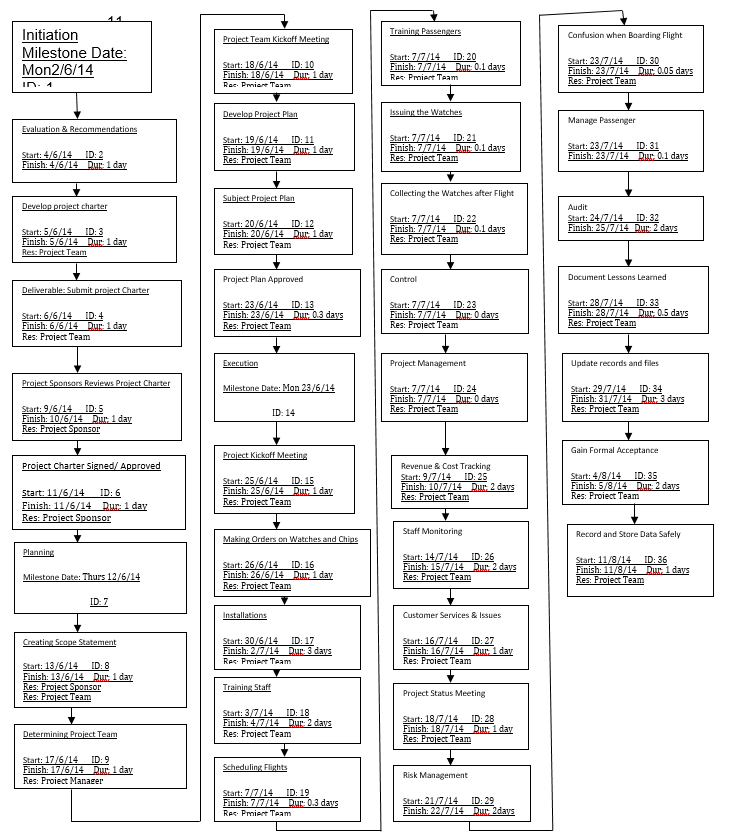
Project Budget
Expenses
Expected Income
Excess Revenue = $787500 – $538526.5= $248973.5
Project’s Budget Estimation
The costs to be incurred during the implementation process are estimated on the basis of prevailing market prices. Online resources were used to provide market information. The choice of goods and services was arrived at following careful considerations. Prices and availability are the most important considerations in lowering the cost of the project. The prices are multiplied by the number of units required.
Budget Assumptions and Constraints
It is assumed that the items and services acquired are of high quality and will be appealing to the passengers. It is estimated that the airline will operate at maximum capacity. The system will not discourage passengers from using the services of the airline. Airbus A380 was used in making the estimates. It can accommodate 525 passengers in a single flight and has 3 travelling classes. Three gates will be used to board the aircraft in order to avoid congestion. Each passenger will require a single watch, which means that only 525 pieces will be needed. Each class will require its own boarding gate. The success of the project will be judged by the number of customers willing to try the new system.
Cost Performance Baseline
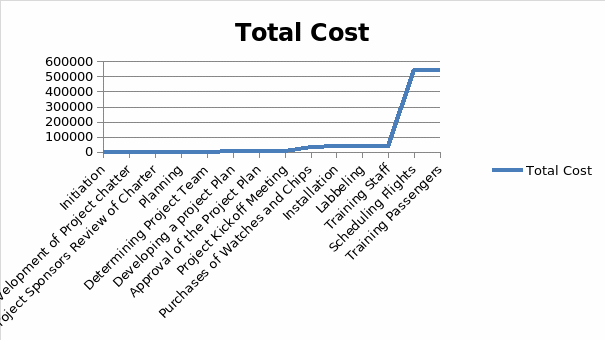
Risk Management Plan
Risks
Risk refers to the probability of failing to meet the objectives of the project. The term can be used to refer to ‘uncertain’ events that may lead to failure. As a result, return on investment reduces if these events take place. Major risks likely to face the project include:
- Confusion among passengers while boarding. As a result, the new system may be viewed as complex and difficult, forcing passengers to avoid the airlines using it.
- Inability to convince airlines to adopt the system. The project cannot be of any use if there is no company willing to make changes to their boarding system.
- Last minute cancellations. If a large number of passengers withdraw, the flight may be cancelled.
- Technological failure may lead to negative publicity. As a result, the system may be viewed as problematic.
Risk Response Plan
Mix ups when boarding the flight are the greatest risk associated with the project. The development will discourage many passengers and airlines from using the system, leading to huge losses. However, confusion can be avoided by training passengers and staff before the flight. Proper labelling using bright colours will also help. Each class should board using a different gate. In the event that problems occur, the passengers will be requested to take the seats next to them as the flight attendants sort out the issue. The problem would be mitigated by making sure that passengers board in a specific order.
Measuring Performance
The performance of the project will be monitored by comparing what has been achieved with what should have been accomplished at a particular time according to the project plan. A variance analysis will be used to determine the performance of the project manager and the team. Below are the performance measurements values for phase one:
- Earned Value (EV): Value of the work already accomplished
- Planned Value (PV): Estimated value of the work to be carried out.
- Actual Cost (AC): Actual amount of money spent.
- Schedule Variance (SV)
- SV=EV–PV
- Cost Variance (CV)
- CV =EV–AC
Schedule Variance (SV) current system of boarding till now:
- SV= $1000 – $1500 = -$500
The SV is negative, meaning that the project is 3 days behind schedule.
Cost Variance (CV) of the current system of boarding till now:
- CV= 1500-2300 = -$800
- CV= -$800
The current boarding system is currently $800 over budget.

